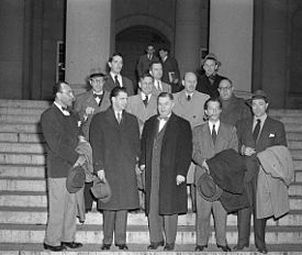The "Hollywood" Blacklist
 Ronald Reagan at the HUAC hearings.
Ronald Reagan at the HUAC hearings.
In 1947, the House Un-American Activities Committee (HUAC) held nine days of hearings that attempted to investigate alleged Communist propaganda and influence in the Hollywood Motion Picture Industry. As an investigative committee of the House of Representatives, the series of hearings was a prominent example of national concern over the spread of Communism so intensely affecting such a specific industry (both in- and outside of Hollywood). Strikes occurring during the late 1930s and 1940s, led many to assert the Hollywood was being overrun by Communist agitators. Then President of the Screen Actors Guild (SAG), and future President of the United States Ronald Reagan testified against such claims. Essential to the HUAC investigations was a column by the founder of The Hollywood Reporter William R. Wilkerson, entitled “A Vote for Joe Stalin” (July 29th, 1946). In the column, Wilkerson provided specific names of people in Hollywood, particularly in the Screen Writer’s Guild, whom he believed to have communist ties. The column itself came to be known as “Billy’s list”, or “Billy’s Blacklist”. Despite being what is believed to be the beginning of “The Hollywood Blacklist”, a role for which Wilkerson’s son later made a public apology, it was not until the conviction of “The Hollywood Ten” that the systematic industry-wide blacklisting began.
 "The Hollywood Ten"
"The Hollywood Ten"
Shortly after the convictions of the “Hollywood Ten” for Contempt of Congress, studio executives under the Motion Picture Association of America delivered a statement formulated during a meeting at the Waldorf-Astoria in New York City. In what became known as the “Waldorf Statement”, the studios announced the firing of the ten men: "We will forthwith discharge or suspend without compensation those in our employ, and we will not re-employ any of the 10 until such time as he is acquitted or has purged himself of contempt and declares under oath that he is not a Communist.” The statement further pledged not to hire anyone known to be part of any group seeking to overthrow the government of the United States, and invited guilds throughout Hollywood to “eliminate any subversives”. The resulting mission to rid Hollywood of subversives actually led to two sources of blacklisting, those summoned to testify in front of the committee, and those named in several publications produced both inside and outside of the film industry.
The difficulty in combating the blacklist was that it was rarely explicit. It was not uncommon to find that others were unwilling to work with individuals because they were merely suspected of being communists or sympathizers. In cases where publications would list names of people, those with similar names might find themselves out of work. The actual number of those placed on the blacklists difficult to ascertain, with some estimates ranging between 150 and 300 artists, directors, radio commenter, actors and screenwriters. It wasn’t until the 1960s that major headway was made in ending the blacklisting.
The difficulty in combating the blacklist was that it was rarely explicit. It was not uncommon to find that others were unwilling to work with individuals because they were merely suspected of being communists or sympathizers. In cases where publications would list names of people, those with similar names might find themselves out of work. The actual number of those placed on the blacklists difficult to ascertain, with some estimates ranging between 150 and 300 artists, directors, radio commenter, actors and screenwriters. It wasn’t until the 1960s that major headway was made in ending the blacklisting.
 "Blacklist" by Jenny Holzer
"Blacklist" by Jenny Holzer
As an example of how public fear can be used in the abuse of authority, the "Blacklisting", which is typically likened to McCarthyism of the same period, continues to effect the industry in many ways. In order "remember the blacklisting and intimidation of creative artists, teachers, and countless other citizens", the Filmic Writing Program in the School of Cinema-Television at the University of Southern California created "The First Amendment/Blacklist Project". Created by artist Jenny Holzer, and composed of 10 stone benches with engraved quotes from the famous "Hollywood Ten", the project is nestled among old olive trees in front of the USC Fisher Museum of Art on Exposition Boulevard, and is intended to serve as a permanent reminder of the events.
Reagan photo Courtesy of Ronald Reagan Presidential Library & Archive
